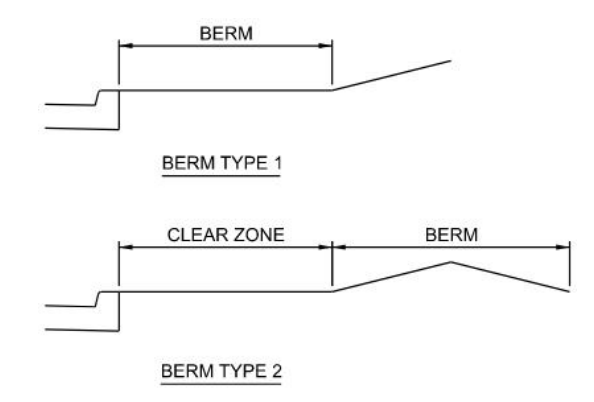4.10.9 Border and Outer Separation
Border
is the area between the roadway and ROW line that may serve several purposes, including but not limited to providing sight distance, a space for separation between pedestrians, bicyclists, and motor vehicle traffic; a sidewalk; or an area for underground and aboveground utilities.A portion of the border area may be used to accommodate snow storage and may include aesthetic features such as grass or landscaping.
Border widths per classification are detailed below:
- Local Roads and Streetsa minimum border of 10-ft should be utilized.
- Collectors,a border width should be at least 12-ft, including the sidewalk width.
- Arterials,a minimum border width should typically be 8-ft, but preferable of 12-ft or more depending on context and nonmotorized user needs.
- Freeways,the border should extend beyond the construction limits, where practical, to facilitate maintenance operations, and encourage an effective roadside design.
Every effort should be made to provide wide borders to serve functional needs. It should be carefully considered in the preliminary design stage to ensure that border width issues will not negatively impact PS&E preparation. For example, if 10-ft SUPs are to be installed on the outside of a pair of frontage roads, which are considered collectors, the 12-ft border width would not permit enough space for illumination or power poles, which are set 3-ft inside of the ROW lines. Utilities are just one important consideration when determining border width.
Target border widths are listed in subsequent chapters per their functional and context classifications.
Outer Separation
is the area between the traveled way of through traffic roadway and a frontage road or street.Such separations function as buffers between the through traffic on the arterial and the local traffic on the frontage road and provide space for a shoulder for the through roadway and ramp connections to or from the through facility. The wider the outer separation, the less influence local traffic will have on through traffic. Wide separations lend themselves to landscape treatment and enhance the appearance of both the highway and adjoining property. A substantial width of outer separation is particularly beneficial at intersections with cross streets because it minimizes vehicle and pedestrian conflicts.
Locations of borders and outer separation along a corridor are detailed in
.

Figure 4-19: Border and Outer Separation Typical Section
Source: AASHTO A Policy on Geometric Design of Highways and Streets
4.10.9.1 Berms
There are two different types of berms typically used on urban streets. The first, constructed as a narrow shelf or path, is typically used to provide a flush grade behind a curb to accommodate the possible future installation of sidewalks. The width of the berm should accommodate a buffer between the curb and the sidewalk, the sidewalk, and any needed buffer on the backside of the sidewalk.
The second type of berm is constructed as a raised mound to facilitate drainage or for landscaping purposes. A raised mound berm should be placed outside of the clear zone, when practical. If it cannot be placed outside of the clear zone, care should be taken to ensure that the slopes and configurations of the berm meet the clear zone requirements as discussed in
.
The first and second type of berms are illustrated in
.

Figure 4-20: Examples of Berms